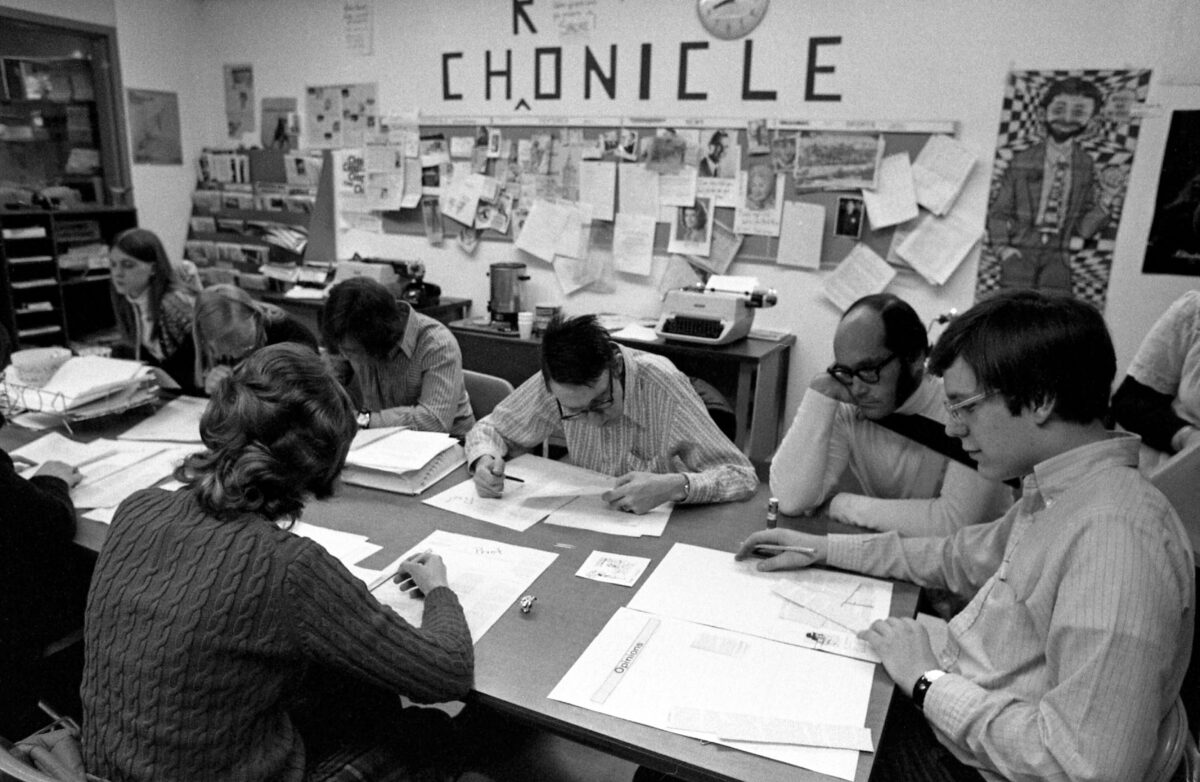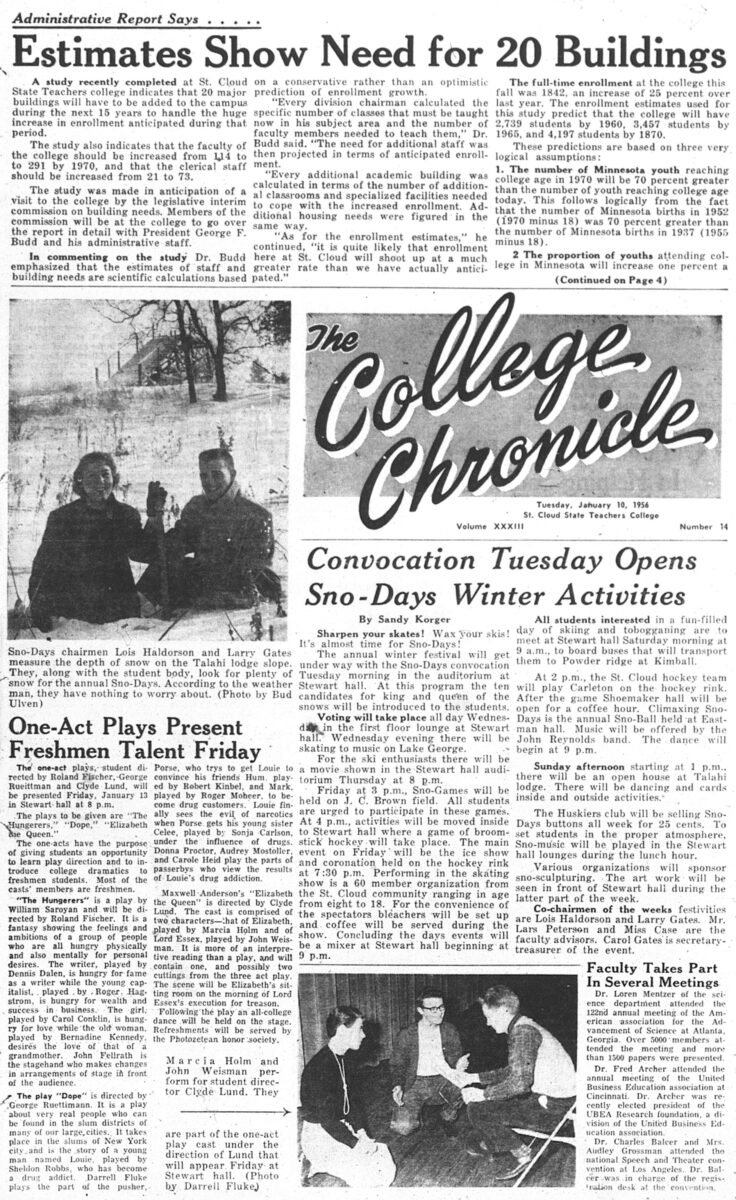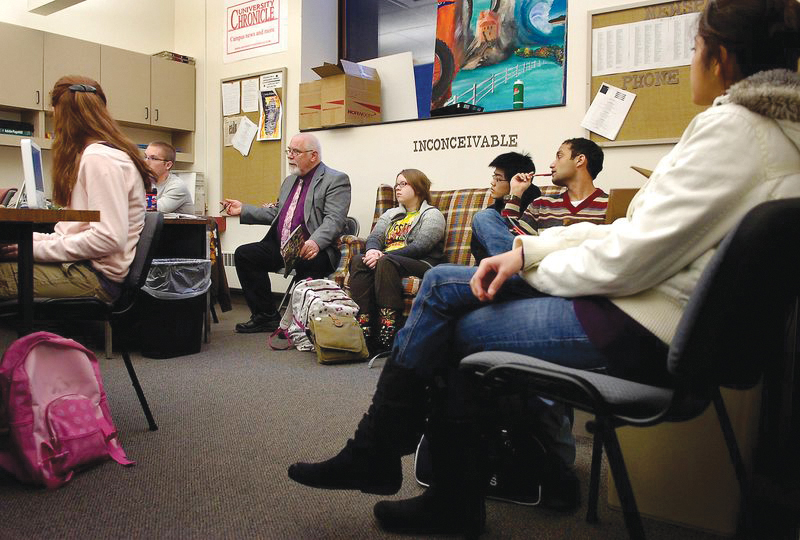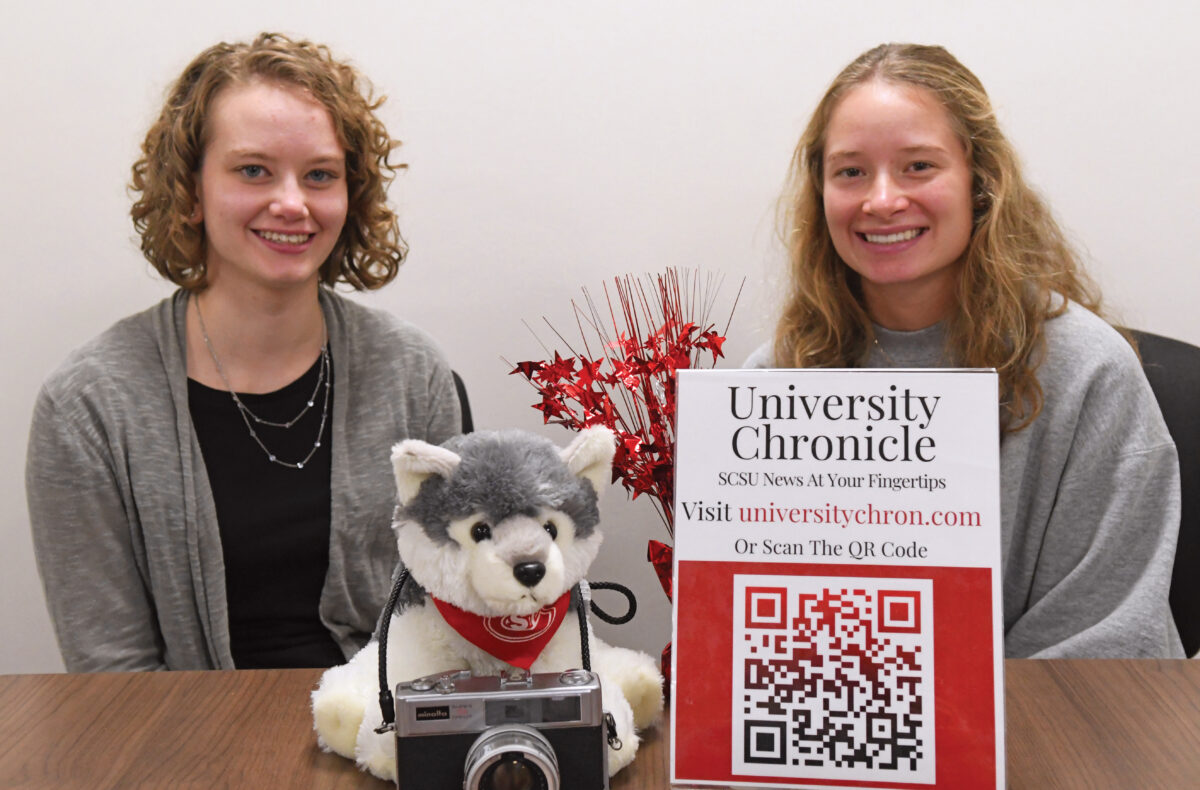
Trailblazing student journalists in fall of 1924 became part of an on-going campus enterprise that would launch hundreds of careers in media and related fields and provide professional-grade reporters and editors for newsrooms across the Midwest and beyond.
Faculty legend Helen Hill recruited from her English classes an editor, Florence Kelly, and a small group of writers to pioneer what would become a vital resource for sharing campus news and building practical skills for budding journalists.
When Hill launched the College Chronicle it had been just three years since the Normal School was elevated to St. Cloud State Teachers College and four years since American women were given the right to vote. The nation was coming out of World War I, and the student paper’s first front page reported that consequently enrollment had nearly doubled to 1,030 from 1921 to 1924.
By its second year, the College Chronicle staff of 26 took high honors at the Fifth Annual Convention of the Central Interscholastic Press Association. The school’s 1925 yearbook wrote: “This staff has put forth a bi-weekly publication of unusual merit which contains current events of interest, faculty columns of value, editorials on the ideas for which the College stands, student opinions, and alumni news, interspersed with spicy jokes and cartoons.”
The tone was set. What is now the University Chronicle has continued to be informative and thought-provoking, earning accolades and awards through times of tremendous growth and change to provide a realistic, relevant experience for student journalists, photographers, ad salespersons, columnists and cartoonists who were in demand and ready to put their skills and their passion for community journalism to work.
Preparing future journalists
“I had three job offers before graduation, said Mike Knaak ’75, who served various positions at the student paper between 1972 and 75. “All were interested in me because of the reporting, editing, editorial writing and photo experience I had at the Chronicle. I finished class on Friday and started at the (St. Cloud) Times the following Monday.”
He credits his Chronicle experience for helping him gain responsibility and trust from the outset.
“I did pretty much everything at the Chronicle – one of the charms of working there,” he said. His first day he was assigned to call then-President Charles Graham to get information for an article. “I wrote a little story and magically it was in print.”
Knaak was joined in his four decades at the St. Cloud Times by a steady stream of Chronicle news and sports reporters and other former editors, including Jeanine Ryan Nistler ’79, Kathy Berdan ’80, Becky Imes Beyers ’85, and Kai Teoh ’12. In between graduation and being hired at the Times, Nistler, Berdan and Beyers had worked for smaller Minnesota papers in Worthington, Mankato, Fergus Falls and Monticello. Each went on to bigger journalism-related jobs, and all had the same high praise for how their Chronicle experience helped them succeed.
Longtime St. Cloud Times Editor John Bodette said his newspaper recruited from many top schools, but St. Cloud State students had a real commitment to community journalism.
“It was invaluable to have that resource,” he said. “When someone had worked there you know they had the skill set and experience to do the work.”

Nistler, who went on to work in communications at SCSU, CentraCare and State of Minnesota Human Services, said she knew from freshman year she wanted to be part of the Chronicle. She started as an arts reporter and early on was sent to interview an artist whose works featured paintings with grids and colored squares.
“Farm girl Jeanine from St. Peter didn’t know what to make of it,” she said. But she learned along the way.
“I had so much fun,” Nistler added. “I think the fun made the learning part of it go down easily. I made some atrocious mistakes along the way, but I’m glad they occurred at a college newspaper rather than the front page of a community newspaper.”
“It was a fabulous experience,” Berdan said of having the guts to jump in and say, “I can do this,” when then-Chronicle adviser J. Brent Norlem told her he wanted her to be editor. She didn’t have much experience writing for the Chronicle, but some of the previous staff stayed around to help her transition to her exciting new venture.
“It was way better than any internship could have been, and pivotal to getting my first job,” Berdan said of her education from the Chronicle. “I started at the Fergus Falls Daily Journal three days after graduation.”
Berdan went from there to being features editor at the St. Cloud Times to the Des Moines Register in 1989 and the Pioneer Press in 2000, always covering arts and entertainment.
Becky Imes Beyers ’85 started at the Monticello Times and two years later moved to the St. Cloud Times, where she worked as copy editor, city editor, and on features and business news. In 1997 she went to the Pioneer Press for nearly 10 years. She went back to school to get her master’s in public affairs and now is senior director of communications and strategy for University of Minnesota Extension.
“Being a Chronicle editor taught me how to be a leader; I think you can’t buy that kind of experience.” Beyers said. “We had a blast. It was hard work but we had fun at the same time. The core group of seven or eight who were on my staff are still in contact.”
For 30 years Kendra Meinert ’89 has been at her “really cool job” as an entertainment and feature writer at the Green Bay Press-Gazette, where she has covered concerts headlined by the likes of Billy Joel and Paul McCartney at Lambeau Field and interviewed stars like Gene Simmons of Kiss, Kenny Chesney, Carrie Underwood and John Prine.
She credits her real-world experience at the Chronicle with giving her the right start.
“As editor I felt it was like a year-long, great internship,” Meinert said. “All the things that go on in the real world I experienced at the Chronicle: deadlines, community and really hard work, crazy hours and deadlines, sometimes working all night. I have wonderful memories of doing pasteup of the paper well into the night Sundays listening to Al Neff on KVSC.”
Kai Teoh ’12 was hired by the St. Cloud Times in 2012, and in 2015 he left to work at publications in New York and Spokane. He currently is the data and interactive news editor for the Dallas Morning News, working remotely managing the newspaper’s data analysis, investigative data and graphics teams.
“The breadth of experience I got from the Chronicle as online editor, managing editor, then executive editor helped me better understand how to help other people do their jobs better, and having done different roles helps me understand my co-workers.”
Teoh came to St. Cloud State as an international student from Malaysia.
“Working at the Chronicle forced me to adapt and get out of my comfort zone and to build rapport and understand the culture,” he said.
Today Teoh does a lot of mentoring with journalism students and international journalists.
“They ask me how I got where I got, and I tell them the pathway to where I am was through (Mass Communications) and the Chronicle. Those were such crucial experiences to me.”

Strong leadership
Chronicle editors were given abundant responsibility and freedom to hone their skill sets and experience journalism, said Heidi Everett, currently associate professor of strategic communications for St. Cloud State. She teaches classes in layout and design, digital content strategy, and social media – embracing all the ways that media has changed and will continue to adapt in ways we cannot imagine.
Everett was editor of the Chronicle in 1993-94, one of only a few editors who were not mass communications majors since the department was created in 1972. She also was a graduate student in English who had always done a lot of writing.
“I loved storytelling. My dream job was to be like Charles Kuralt and travel the country meeting everyday people.”
Everett had the skill set the Chronicle needed – writing and editing – so she joined and learned.
“I absolutely fell in love with the deadlines,” she said. The staff was about two dozen, including many ad salespersons who brought the revenue that helped keep the Chronicle functioning as an independent entity. They came together practicing team collaboration for a common goal.
“These are important lessons,” said Everett. “Every skill students are learning in mass communications is applicable to any industry and organization.”
Like others who served as editors during the 25 years mass communications professor Michael Vadnie was adviser to the Chronicle, Everett appreciated his trust and guidance that encouraged editors and reporters to think decisions through.
“He would ask why you wanted to do something and if you could justify it.”
An example was Everett’s decision to spoof the high profile Vanity Fair magazine cover with pregnant actor Demi Moore on the Chronicle’s annual April Fool’s satire edition that capitalized on popular culture. Everett was married and pregnant at the time and saw it as an opportunity to draw attention to the issue.
“I was asked to step down” by a critical administrator, she said, but Vadnie stood by her. Another controversial decision was to include coverage of an issue that involved a student of color being charged with resisting arrest, a case that Everett believed hinged entirely on the student’s prolific use of the F-word during the interaction with police.
“It was during these times that Vadnie was a great adviser,” Everett said. “His advising was what made that experience exceptional. He let us work it out.”
“As an adviser I was there for them,” said Vadnie, who had a background as both a cops and courts reporter for the Grand Forks Herald and had a law degree. “I was proud that we were independent and lived up to it every single day. We did our best to live up to the level of a professional paper, encouraging the staff to write hard, die free – to write the truth and do their best.”
Vadnie’s influence on students to practice ethical journalism was not lost on the newspeople who hired Chronicle graduates.
“I credit Vadnie for his defense of First Amendment issues and the great exposure to them he gave his students,” Bodette said.
Vadnie’s first Chronicle editor in 1988- 89, Tim Hennagir, established his career adhering to those tenets of community journalism as a student leader, adjunct professor and 13-year Chronicle adviser following Vadnie’s retirement, and 35-year professional journalist for a variety of publications. Currently a reporter for the Sauk Rapids Herald, the state’s oldest newspaper established in 1854, Hennagir keeps in mind Vadnie’s admonishment to be a “human being first, journalist second” as he covers people and news in Avon, Albany and Sauk Rapids, in Benton County.
As an editor and instructor, he loved teaching them to take the time to listen and remember as journalists they will deal with people on their best days and their worst days.
“You just have them for that one white-hot second that might teach them the concept of ethical journalism,” said Hennagir. “The education I received at St. Cloud State took me all over the world, broadened me.”
Hennagir’s passion for practicing good journalism is ongoing. As journalists, some stories require extracting information with finesse, and others “kicking down doors to get the story.” His time at the Chronicle was the foundation for Hennagir’s deeply-held love for journalism and gratitude for people who touch the lives of others and take the time to tell their stories.
For Eric Dietz, who was managing editor from 1999-2000 and is currently adviser to the University Chronicle, the learning experience went beyond reporting, writing and editing. During his junior year, he moved the paper from analog to digital.
“It was a huge education I was not going to get elsewhere,” he said. “It was a slow transition from large tabloid layout to being completely digital.”
“The university hired me in my junior year to do it,” he added. “I was doing some of the things I still do today. The large skills came from my time at the Chronicle.”

A critical function
From the days when Helen Hill was College Chronicle adviser (1924-48), the student newspaper has ebbed and flowed with the times and connected the campus with the world. For example, in 1944 during World War II, the staff of 20 led by editors Alice Binger and Maxine Johnson declared in each issue the motto, “This paper is a ‘VOICE for VICTORY.’” They turned the fourth page into a servicemen’s page, and on the back page letters and sto- ries about men and women in Uncle Sam’s forces were regularly featured.
During 1973-75 when Knaak was at the Chronicle, the Vietnam War was ongoing and human rights, women’s rights and equity issues that affected students were important topics for coverage.
“We were becoming a more diverse campus with a growing number of students of color and we started to see changes in curriculum and awareness of the world,” he said.
The Chronicle also covered stories that were very important for the university, such as what was happening in those early days of the faculty union and for the first time printing faculty salary lists, Knaak said. “We were very aggressive about holding people accountable.”
In the days since, the world has seen many changes in the media and the general public’s access to balanced journalism. In October Poynter, a publication of the Poynter Institute, reported that “a new Medill study estimates that an eye-popping 7,000 newspaper jobs – about a third of them in newsrooms – were lost in 2023.” Additionally, there were 127 newspaper closings and more than 1,500 counties with a combined 55 million residents that are down to no or only one source of local news.
“But what hasn’t changed is still the need for good journalism,” Knaak said. “It doesn’t matter if it’s on a dead tree or on your phone. The product has not changed. A good story’s a good story. Some combination of video, more than words on a page, the basics of reporting, writing and editing have not changed. Trusted media is still trusted media.”
The University Chronicle is diminished in size and staff, but according to Emma Bast, who has served as editor for the past two years, it remains a strong learning experience and has recently moved to a new office space in Stewart Hall. Her co-editor Cambrie Kowal will be taking over as editor in spring semester 2025.
“I can already tell that the industry is moving toward a fast and digital means,” Bast said. “If you are working in print, you have to be able to do digital and social media too. If you are a reporter for TV, you have to be able to write your stories for the digital website and put up a tease for a streaming platform. It is no longer feasible to only be good at one thing. You have to do it all.
“And all of it revolves around strong writing skills,” added Bast. “If you don’t have that, you will not go anywhere in the journalism industry. Everything has to be done faster and be able to be on multiple platforms quickly. Adaptability and urgency are key.”
Bast will graduate in December 2024 and has plans to become a television news producer. After a century of relevance on campus and a long track record of successful editors, the Chronicle has a special place in Bast’s heart.
“My time at the University Chronicle has taught me a few things, among them the importance of out-of-class involvement,” Bast said. “You can only learn so much in a classroom, especially in an industry that is always changing, so having the Chronicle be one of the places where you can learn even a small bit of the media industry is fantastic.”
